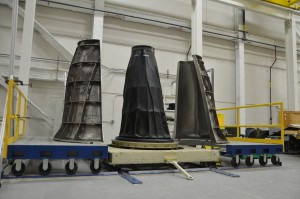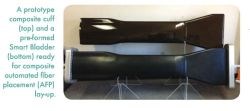Inflexion technology: complex composites without fasteners
Spirit AeroSystems has developed production methods using rigid-flexible tooling for more affordable unitized composite aerostructures.
Share

Spirit AeroSystems’ Inflexion technology enables manufacture of large, complex composite aerostructures in one continuous piece that are lighter, more affordable and more efficient.
SOURCE: Spirit AeroSystems
In 2013, Spirit AeroSystems (Wichita, KS, US) announced that it was working with Spintech (Xenia, OH, US) to develop new tooling technology for manufacturing complex composite aircraft structures. Trademarked as Inflexion, the technology is based on re-formable, reusable mandrels, and touted as enabling integrated composite structures with features not possible to achieve using traditional tooling.
Traditional composite structures manufacturing uses rigid tooling that must be removed from inside the part. But this limits the size and complexity of structures. Inflexion tooling can be transitioned between rigid and flexible states for easy removal, regardless of part size and complex geometries. As explained by Spintech engineering director Tom Margraf in a 2013 interview:
“The composites manufactured using Inflexion are structures that integrate engineering stiffeners such as frames, stringers, spars, and longerons with skin panels that are co-cured in a single cure process. The inflexion process eliminates the need for secondary bonding and/or fastening of engineering stiffeners, which enables lower cost, lighter weight, and more damage tolerant structures.”
Years in the Making
Spirit AeroSystems began working on Inflexion in 2005, collaborating with Cornerstone Research Group (CRG, Dayton, OH, US), which had developed tooling using its patented shape memory polymer (SMP) materials. CRG spun off Spintech Ventures LLC in 2010 to refine the technology and scale it up for industrial aerostructures production. Spintech offers the technology under the trade name Smart Tooling (follow the link to see videos of how the technology works). Spirit’s version reportedly includes enhancements it has developed for producing large, integrated structures with singled-sided reinforcements (e.g., stiffeners).


Spirit's Inflexion technology is based on Smart Tooling which uses
shape memory polymer (SMP) materials to enable rigid layup tools
that become elastomeric after cure for easy extraction.
SOURCE: Cornerstone Research Group (CRG) and Spintech/Smart Tooling.
CRG completed a Phase II Small Business Innovation Research (SBIR) project with NAVAIR, demonstrating Smart Tooling’s benefits. During the 2011 Navy Opportunity Forum, Spintech summarized these as including increased throughput, which reduces total process time; increased repeatability from part to part due to a rigid, net-shaped, layup tool; and up to an 80% reduction in manufacturing cost.
"Smart Tooling's patented technology allows composite manufacturers to significantly reduce a combination of labor, material, and capital cost, while significantly increasing production throughput of composite parts with trapped features and/or complex shapes," said previous Spintech president Craig Jennings.
According to a 2013 press release, Spirit Aerosystems acting director of technology Bill Smith explained that Inflexion allows “extraction of the tool in spite of trapping features which would hinder current tooling methods. This enables, for example, the full integration of skins, stringers, and frames or ribs in one step."
Investment for Future Contracts
In the 2013 The Wichita Eagle article “Spirit’s ShadowWorks, a technology investment,” author Molly McMillin asserts that Spirit AeroSystems’ investment into innovative technologies like Inflexion is aimed at helping the company win new programs and retain customers. Quoting Spirit research and development engineer Allison Wright, Madison writes that Spirit “looks to provide customers the capabilities they need in their products — lower weight, more efficiency or better manufacturing processes.” She notes that cost is also key as Spirit competes with other large firms for contracts from aerospace OEMs.
This article too quoted Spirit’s technology/R&D director Bill Smith: “It’s not about putting in ‘gee whiz’ technology for the sake of technology. It’s for the requirements and capabilities that an airplane needs. ... It’s about, ‘Can you offer more cost-effective solutions than your competitors?’ ” He pointed out that there are consequences to missing out on new programs. “If you lose one, you don’t wait until next week for a new airplane program to come in. The winner takes it all.”
Inflexion was then described in the article as an example of Sprit AeroSystems’ investment in innovation: The tooling made from the [shape memory] polymers remains rigid for winding and curing the materials, but additional heat allows it to become flexible, where it can be stretched, reshaped and pulled away. The article quotes Spirit research and design engineer Carl Fiegenbaum, “It goes from a hard tool to a soft tool during the curing process.” He explains that ability lets the composite stringers, frames or other components be integrated into a single structure. Smith added, “The more I can integrate composite features, the lower the cost. The idea is to do everything at once.”
The article goes on to say Spirit was testing the process on a 40-inch fuselage barrel and that the Inflexion Smart Tooling could be reused and formed back to that shape or another shape for multiple cycles. Spintech said in a 2014 article that it had demonstrated a life of 40 cycles for Smart Tooling vs. 6-10 cycles for the baseline tooling systems. Spirit actually showed off a cylindrical composite structure at the 2012 Farnborough International Airshow, as reported by Jeff Sloan and Bob Griffiths:
Spirit AeroSystems (Wichita, Kan.) had two technically intriguing parts on its stand. … The second part was a cylindrical structure with internal stiffeners. Historically, parts with trapping geometries have required multipart tools that can be disassembled to permit postcure removal. These come at great expense and require constant maintenance. Spirit claims to have developed a “reconfigurable” tooling process called Inflexion that has reduced its tooling costs.
McMillin winds up the Inflexion section of her article by quoting Smith as saying Spirit would roll out the Inflexion technology on “fairly near-term programs in smaller ways,” and then build up to larger applications. Figgenbaum added, “There’s a variety of architectures and design philosophies and configurations that we believe would be well suited” for the process. “It’s not the perfect thing for everything. But there are places where it’s really well suited.”
Related Content
Next-generation airship design enabled by modern composites
LTA Research’s proof-of-concept Pathfinder 1 modernizes a fully rigid airship design with a largely carbon fiber composite frame. R&D has already begun on higher volume, more automated manufacturing for the future.
Read MoreASCEND program update: Designing next-gen, high-rate auto and aerospace composites
GKN Aerospace, McLaren Automotive and U.K.-based partners share goals and progress aiming at high-rate, Industry 4.0-enabled, sustainable materials and processes.
Read MoreComposites manufacturing for general aviation aircraft
General aviation, certified and experimental, has increasingly embraced composites over the decades, a path further driven by leveraged innovation in materials and processes and the evolving AAM market.
Read MoreA new era for ceramic matrix composites
CMC is expanding, with new fiber production in Europe, faster processes and higher temperature materials enabling applications for industry, hypersonics and New Space.
Read MoreRead Next
Plant tour: Daher Shap’in TechCenter and composites production plant, Saint-Aignan-de-Grandlieu, France
Co-located R&D and production advance OOA thermosets, thermoplastics, welding, recycling and digital technologies for faster processing and certification of lighter, more sustainable composites.
Read MoreDeveloping bonded composite repair for ships, offshore units
Bureau Veritas and industry partners issue guidelines and pave the way for certification via StrengthBond Offshore project.
Read MoreAll-recycled, needle-punched nonwoven CFRP slashes carbon footprint of Formula 2 seat
Dallara and Tenowo collaborate to produce a race-ready Formula 2 seat using recycled carbon fiber, reducing CO2 emissions by 97.5% compared to virgin materials.
Read More






















